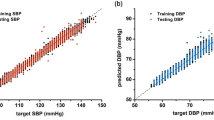Abstract
With the increasing number of hypertension patients, the monitoring of blood pressure information becomes an important task. In this study, an end-to-end approach is proposed to estimate blood pressure from the pulse wave signal. In this approach, a normalized single pulse wave is the input of a neural network, which consists of the convolutional layers and the recurrent layers, then outputs the corresponding blood pressure. The convolutional layers consist of one-dimensional convolutional layers and depth-separable convolutional layers. The gated recurrent unit (GRU) is used in the recurrent layer. Finally, a dense layer is used to output estimated values of blood pressure. In comparison with previous approaches, the proposed method does not require complicated feature extraction. It is only necessary to input a single pulse wave into the neural network and blood pressure can be estimated. The proposed approach is tested in the multi-parameter intelligent monitoring in intensive care (MIMIC) dataset, and the average absolute error is 3.95 mmHg for systolic blood pressure and 2.14 mmHg for diastolic blood pressure. This result fulfills the international standard of blood pressure measurement, which shows the proposed approach is simple and effective. In practice, the proposed method is designed to obtain blood pressure information from pulse waves.
Access this chapter
Tax calculation will be finalised at checkout
Purchases are for personal use only
Similar content being viewed by others
References
Association for the Advancement of Medical Instrumentation (1996) American national standard for electronic or automated sphygmomanometers. In: ANSI/AAMISP10-1992/A1,Arlington,VA, USA
Teng XF, Zhang YT Continuous and noninvasive estimation of arterial blood pressure using a photoplethysmographic approach. In: Presented at the 25th annual international conference of the IEEE engineering in medicine and biology society
Kurylyak Y, Lamonaca F, Grimaldi D (2013) A neural network-based method for continuous blood pressure estimation from a PPG signal. In: Presented at 2013 IEEE I2MTC
Gao SC, Wittek P, Zhao L, Jiang WJ Data-driven estimation of blood pressure using photoplethysmographic signals. In: Presented at IEEE EMBC annual international conference
Wang L, Zhou W, **ng Y et al (2018) A novel neural network model for blood pressure estimation using photoplethesmography without electrocardiogram. J Healthc Eng 1:1–9
Wu YD, Zhong SC, Shen YC (2017) Noninvasive continuous blood pressure measurement method based on SWT and ANN. Inf Med Equip 5(32):22–27
Wen L, Li ZB, Chen JP et al (2014) Blood pressure measurement algorithm of neural network based on Gaussian fitting. Transducer Microsyst Technol 4(33), 132–134 + 138
Goldberger AL, Amaral LA, Glass L et al (2000) PhysioBank, PhysioToolkit, and PhysioNet: components of a new research resource for complex physiologic signals. Circulation 101(23):E215–E220
Moody GB, Mark RG (1996) A database to support development and evaluation of intelligent intensive care monitoring. Comput Cardiol 23:657–660
Krizhevsky A, Sutskever I, Hinton GE ImageNet classification with deep convolutional neural networks. In: Presented at international conference on NIPS
Simonyan K, Zisserman A (2014) Very deep convolutional networks for large-scale image recognition. Comput Sci
He K, Zhang X, Ren S et al Deep residual learning for image recognition. In: Presented at IEEE conference on CVPR
Cho K, Van Merrienboer B, Gulcehre C et al (2014) Learning phrase representations using RNN encoder-decoder for statistical machine translation. Comput Sci
Amodei D, Anubhai R, Battenberg E et al (2015) Deep speech 2: end-to-end speech recognition in English and Mandarin. Comput Sci
Graves A (2013) Generating sequences with recurrent neural networks. Comput Sci
Graves A, Jaitly N. Towards end-to-end speech recognition with recurrent neural networks. In: Presented at the 31st international conference on ML
Hochreiter S, Schmidhuber J (1997) Long short-term memory. Neural Comput 9(8):1735–1780
Jozefowicz R, Zaremba W, Sutskever I An empirical exploration of recurrent network architectures. In: Presented at international conference on machine learning
Chung J, Gulcehre C, Cho KH et al (2014) Empirical evaluation of gated recurrent neural networks on sequence modeling. Comput Sci
Zeiler MD (2012) ADADELTA: an adaptive learning rate method. Comput Sci
Srivastava N, Hinton G, Krizhevsky A et al (2014) Dropout: a simple way to prevent neural networks from overfitting. J Mach Learn Res 15(1):1929–1958
Ioffe S, Szegedy C (2015) Batch normalization: accelerating deep network training by reducing internal covariate shift. Comput Sci
Altman DG, Bland JM (1983) Measurement in medicine: the analysis of method comparison studies. The Statistician 32(3):307–317
Author information
Authors and Affiliations
Corresponding author
Editor information
Editors and Affiliations
Rights and permissions
Copyright information
© 2020 Springer Nature Singapore Pte Ltd.
About this paper
Cite this paper
Wang, C., Yang, F., Yuan, X., Zhang, Y., Chang, K., Li, Z. (2020). An End-to-End Neural Network Model for Blood Pressure Estimation Using PPG Signal. In: Liang, Q., Wang, W., Mu, J., Liu, X., Na, Z., Chen, B. (eds) Artificial Intelligence in China. Lecture Notes in Electrical Engineering, vol 572. Springer, Singapore. https://doi.org/10.1007/978-981-15-0187-6_30
Download citation
DOI: https://doi.org/10.1007/978-981-15-0187-6_30
Published:
Publisher Name: Springer, Singapore
Print ISBN: 978-981-15-0186-9
Online ISBN: 978-981-15-0187-6
eBook Packages: EngineeringEngineering (R0)




